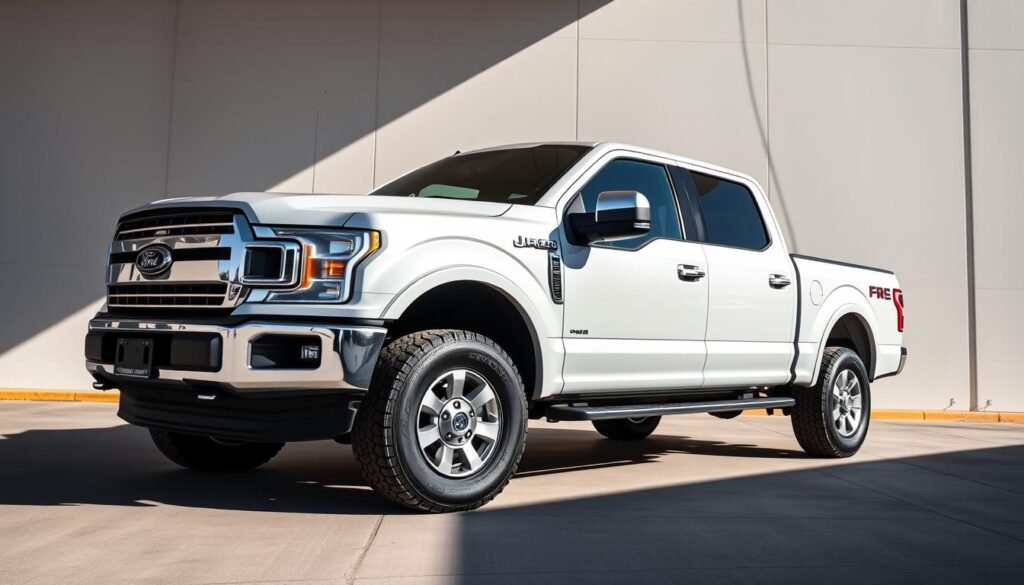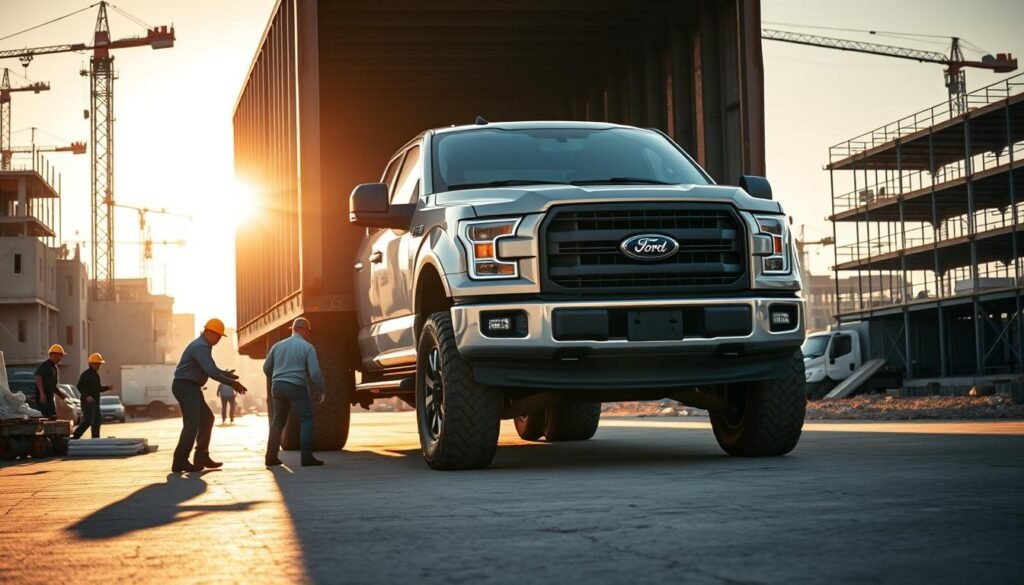How Much Does A Ford F150 Weight? Exclusive Guide
A Ford F150’s weight ranges from 4,021 to 5,540 pounds. It varies by model year and trim. This guide covers the how much does a Ford F150 weight?
including curb weight, payload capacity, and gross vehicle weight. Knowing these numbers is key for understanding what you can tow and carry.
It helps you get the most from one of America’s top trucks. This guide explains the different weight types for the Ford F150.
You’ll learn about curb weight, important for daily use, and payload capacity, which matters when carrying heavy loads.
Plus, we’ll show how the model year affects your truck’s weight. By the end of this guide, you’ll know the Ford F150’s weight and why it’s vital for your truck’s use and performance. Ready to learn more? Let’s start!
Overview of The Ford F150
The Ford F150 leads the full-size truck category, known for its high performance, capability, and advanced technology.
It’s celebrated as the top full-size truck for many reasons. The ford f150 overview showcases its strong design and the wide range of ford f150 features suitable for both work and fun.
This model provides various engine options to choose from. These options make sure you get power but also save on fuel.
Plus, you can pick from different body styles and interior upgrades. The latest model shows Ford’s focus on eco-friendly solutions and the latest tech, guaranteeing modern features and dependability.
What is Ford F150 Weight Specifications?
When looking at the ford f150 weight specs, it’s key to get the different weights. Each type affects the truck’s road performance.
Knowing these helps use your truck right, keeps you safe, and follows the law.
Types of Weights
Here are several vital measures for every ford f150 owner:
- Curb Weight: This is the truck’s weight without cargo or passengers. It’s the starting point to figure out how much more weight is safe to add.
- Payload Capacity: This shows the highest weight of cargo and passengers the truck can carry. It helps avoid safety risks from overloading.
- Gross Vehicle Weight (GVW): This is the whole weight when the truck is loaded. It combines curb weight and payload. Knowing your GVW keeps you within legal weight limits.
Importance of Knowing The Weight
Why understanding these weights matters:
- It increases safety by stopping overloads, which can cause accidents or damage the vehicle.
- It makes the truck perform better by ensuring it works within its limits. This improves control and stability.
- It helps you follow weight limit laws, which differ across states and local areas.
Knowing about the different weights and their significance helps you manage your vehicle better. It makes driving safer and more enjoyable.
How Much Does A Ford F150 Weigh?
The weight of a Ford F150 changes based on the year and trim. Knowing this can help you understand its performance and ability.
Weight Variations by Model Year
The design and engineering of the F150 have evolved over time. For example, the 2020 model weighs between 4,069 and 5,697 pounds. This depends on its features and build.
Older models are lighter because they have less tech. But newer ones are heavier due to improvements in safety and comfort.
Curb Weight of Different Trims
The weight of the F150 varies with different trims. Base models are lighter, while high-end ones like Platinum and Limited are heavier.
They have more features. This info is key when looking into how much the truck can tow and its overall drive.
Ford F150 Curb Weight Explained
The curb weight of your Ford F150 is key to knowing what it can do. It’s the truck’s weight without any passengers or cargo, but with necessary fluids like oil and a full tank of gas.
Knowing curb weight is vital for handling payloads and the truck’s overall performance.
What is Curb Weight?
Curb weight is crucial for assessing a vehicle. For the Ford F150, this weight changes based on the model year and trim.
Knowing the curb weight helps you figure out the truck’s efficiency, manage how much you can load it, and keep it safe to drive.
Typical Curb Weight Range
The Ford F150’s curb weight usually falls between 4,069 to 5,697 pounds. This variation is due to the different models and features over the years.
Knowing this helps you understand how much more weight your truck can carry without compromising on performance.
| Model Year | Trim Level | Curb Weight (lbs) |
|---|---|---|
| 2021 | XLT | 4,069 |
| 2021 | Lariat | 4,475 |
| 2021 | King Ranch | 5,000 |
| 2021 | Platinum | 5,250 |
| 2021 | Limited | 5,697 |

Ford F150 Payload Capacity
When looking at a Ford F150, knowing its payload capacity is key. What does payload capacity mean? It’s the max weight the truck can carry safely.
This includes everyone in the truck and anything you’re hauling. For the Ford F150, knowing this helps you figure out how much you can carry without going over the limit.
What is Payload Capacity?
The Ford F150’s payload capacity can change a lot, depending on the model and how it’s built.
It might be as low as 1,000 pounds or more than 3,000 pounds. The truck’s materials and the design of its suspension play a big part in this.
Factors Affecting Payload Capacity
Many things can affect how much your Ford F150 can carry:
- Chassis Design: The truck’s frame affects its strength and how much it can hold.
- Suspension System: A strong suspension lets the truck carry more weight and stay stable.
- Engine Type: Different engines can handle different amounts of weight, based on their power.
- Trim Level: Some versions of the truck can carry more because of how they’re equipped.
| Model Year | Payload Capacity (lbs) |
|---|---|
| 2021 | 2,238 |
| 2022 | 3,325 |
| 2023 | 3,325 |
Ford F150 Gross Vehicle Weight
The Gross Vehicle Weight (GVW) of the Ford F150 includes everything – the truck, cargo, and passengers. It changes with different models and setups.
The weight of a Ford F150 can be between 6,100 and 7,050 pounds, depending on the model. This info is key for following weight limits and checking how the truck handles loads.
To show the differences in GVW, here’s a table with weights for various Ford F150 models.
| Model Year | Trim Level | Gross Vehicle Weight (lbs) |
|---|---|---|
| 2023 | XLT | 6,300 |
| 2023 | Lariat | 6,600 |
| 2023 | King Ranch | 6,800 |
| 2023 | Platinum | 7,050 |
| 2022 | XLT | 6,250 |
| 2022 | Lariat | 6,550 |
| 2022 | King Ranch | 6,750 |
| 2022 | Platinum | 7,000 |
Knowing the F150’s weight limit is key to not going over legal limits. It helps drive safely and efficiently, especially with big loads.
Always check your owner’s manual or ask a Ford dealer to make sure about your F150’s GVW.

Learning F150 Weight Distribution
Knowing your Ford F150’s weight distribution is key for both performance and safety. It helps you know how the truck’s weight is spread across its axles. This affects how well it handles and how stable it is.
If the weight isn’t balanced right, you could face many problems. So, always make sure your truck’s weight is properly distributed.
What is Weight Distribution?
Weight distribution shows how the truck’s weight is shared between the front and back axles.
This is important for your F150’s performance, especially when it’s carrying heavy loads or when you’re towing. A well-balanced truck drives better and is safer.
Importance of Proper Weight Distribution
Getting the weight distribution right means your truck will handle better and be safer. When the load is not balanced:
- Poor steering response
- Increased wear on suspension components
- Reduced braking efficiency
- Higher chances of rollovers under extreme conditions
Strive for an even weight distribution to keep your truck performing well and safe. This will also help your truck last longer and make driving more enjoyable.
F150 Weight Limit Considerations
It’s vital to know your Ford F150’s weight capacity for safety and efficiency. Several weight limit factors impact this truck’s limits. Knowing them ensures your drive is safe and efficient.
Factors Influencing Weight Limits
Different specs that are key to the F150’s design and performance set its weight limit. Important factors include:
- Engine Specifications: The engine’s power and torque decide how much the truck can carry.
- Axle Ratings: Stronger axles mean the truck can carry more weight.
- Suspension Systems: A good suspension spreads weight well, adding stability.
- Tire Specifications: Tires for higher weights help with carrying more safely.
Safety and Efficiency Guidelines
Following truck safety guidelines helps you stay within the F150’s weight limits. Overloading can cause breakdowns, make steering harder, and create dangers on the road.
Here are tips to follow:
- Check the truck’s weight capacity in the owner’s manual often.
- Use a weight distribution system for towing heavy loads.
- Keep the load balanced for better stability and safety.
- Make sure tires are at the right pressure for heavy loads.

Keeping these points in mind will help you get the best out of your Ford F150. Plus, it keeps you and others safe on the road.
Comparing F150 Weight To Other Trucks
When we compare the weight of the F150 to other trucks, important things stand out. Its design and weight distribution make it unique among big trucks. This design offers both strength and top performance.
Why F150 Stands Out?
The F150 is often a bit heavier than trucks like the Chevrolet Silverado and Ram 1500. This extra weight means it’s often stronger, which is great for towing more weight.
Buyers who need a top-performing truck for heavy lifting find this very important.
Performance Implications
Weight affects how a truck performs. The F150’s weight helps it stay steady on the road, offering a smooth ride.
This balance is especially noticeable on tough roads or when the truck is fully loaded.
| Truck ModelWeight (lbs)Towing Capacity (lbs)Payload Capacity (lbs) | |||
|---|---|---|---|
| Ford F150 | 4,000 – 5,600 | 5,000 – 14,000 | 1,400 – 3,325 |
| Chevrolet Silverado 1500 | 4,200 – 5,400 | 6,000 – 13,400 | 1,500 – 2,300 |
| Ram 1500 | 4,800 – 5,500 | 6,000 – 12,750 | 1,300 – 2,300 |
Looking at the data helps us see the F150’s strengths. Knowing these details can guide you in picking the best truck for your needs.
Real-World Implications of F150 Weight
The Ford F150’s weight is crucial in different driving situations. It affects towing and hauling performance and how much gas you use. Knowing this helps you choose a truck that fits how you drive.
Towing and Hauling Performance
A heavier F150 is more stable and easier to handle when you’re towing. This keeps your stuff safe, especially on rough roads.
The extra weight means you can trust your truck more when driving gets tough.
Impact on Fuel Efficiency
But, a heavier truck uses more fuel. As you drive, you’ll see how weight affects gas mileage. Knowing this helps you think about costs and choose the right F150 for you.

| Weight ClassTowing Capacity (lbs)Fuel Efficiency (MPG) | ||
|---|---|---|
| Lightweight | 7,000 | 22 |
| Standard | 11,000 | 18 |
| Heavy Duty | 13,200 | 15 |
Ford F150 Weight and Fuel Economy
The link between the Ford F150’s weight and its fuel efficiency is key for owners. A heavier Ford F150 uses more fuel, especially when speeding up or towing.
Knowing this helps you choose better driving practices and towing limits. Ford’s EcoBoost engines use advanced tech to power the F150 efficiently.
Despite the truck’s weight, these engines don’t guzzle more gas. They achieve a good balance of power and fuel economy, maintaining performance.
Conclusion
Knowing the Ford F150’s weight specs is key for owners and potential buyers. This guide covered the Ford F150’s weight, including curb weight, payload, and gross vehicle weight.
This info helps you make smart choices and use your truck well every day. Think about the F150’s weight when picking your truck.
Knowing this can make your drive better, safer, and within the rules. This is true whether you’re towing, carrying loads, or just driving around.
The Ford F150 has different weights and abilities for various needs. By remembering these weight facts, you can make your truck work better and more efficiently.
Use this guide as a helpful tool for your Ford F150 adventure.
FAQs
Q: How much does a Ford F150 weigh?
A: The weight of a Ford F150 changes based on the year and trim. It ranges from about 4,069 to 5,697 pounds.
Q: What is the curb weight of the Ford F150?
A: The curb weight is what the truck weighs when it’s empty but has all the necessary fluids. It varies between 4,069 and 5,697 pounds across different models.
Q: What is the payload capacity of the Ford F150?
A: The Ford F150’s payload capacity can be between 1,000 to over 3,000 pounds. This depends on the model and how it’s set up.
Q: What is the gross vehicle weight of a Ford F150?
A: The gross vehicle weight (GVW) of the Ford F150 can be from 6,100 to 7,050 pounds. This varies with the model and what’s on it.
Q: How does weight distribution affect the Ford F150?
A: Good weight distribution helps with stability, control, and safety. This is key when the truck is carrying a load or towing.
Q: What factors influence the weight limit of the Ford F150?
A: The weight limit is affected by the engine, axle ratings, and suspension. These are important for the truck’s safety and performance.
Q: How does the weight of the Ford F150 compare to other trucks?
A: The Ford F150 might be heavier than some other trucks. But its design ensures it’s strong and can tow well.
Q: How does the weight of the Ford F150 impact fuel efficiency?
A: A heavier truck uses more gas, especially when speeding up or towing. Yet, newer technology is making these trucks more fuel-efficient.







